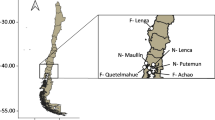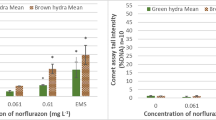Abstract
This study tests the responses of juvenile gametophytes and tetrasporophytes (holdfast stage) of the isomorphic alga Gracilaria verrucosa under different environmental conditions.
Estimations of survival and growth of holdfasts of haploid and diploid juvenile individuals were performed in natural sea-water and artificial culture medium, and under stringent conditions using lead as a toxin and ultra violet radiation as a mutagen. Results indicate that (i) holdfasts of haploid juveniles grow better than diploids in non-optimal medium conditions; (ii) holdfasts of diploid juveniles have a better tolerance to lead than haploids; and (iii) slight advantage of holdfasts of diploid juveniles grow better than haploids under U.V. radiation.
Similar content being viewed by others
References
Adams, J. & P. E. Hansche, 1974. Population studies in microorganisms I. Evolution of diploidy in Saccharomyces cerevisiae. Genetics 76: 327–338.
Bernstein, H., H. C. Byerly, F. A. Hopf & R. E. Michod, 1985. Genetic Damage, Mutation, and the Evolution of Sex. Science 229: 1277–1281.
Bodard, M., 1973. Réflexions sur les cultures d'Algues rouges à partir de boutures. Bull. Soc. Phycol. Fr. 18: 20–30.
Cavalier-Smith, T., 1978. Nuclear volume control by nucleoskeletal DNA, selection for cell volume and cell growth rate, and the solution of the DNA C-value paradox. J. Cell Sci. 34: 247–278.
Crow, J. F. & M. Kimura, 1965. Evolution in sexual and asexual populations. Am. Nat. 909: 439–450.
Destombe, C., J. Godin, Cl. Lefebvre, O. Dehorter & Ph. Vernet, 1992. Differences in dispersal Abilities of Haploid and Diploid spores of Gracilaria verrucosa (Gracilariales, Rhodophyta). Bot. mar. 35: 93–98.
Destombe, C., M. Valero, Ph. Vernet & D. Couvet, 1989. What controls haploid-diploid ratio in the red alga, Gracilaria verrucosa. J. evol. Biol. 2: 317–338.
Galun, E. & D. Raveh, 1975. In vitro culture of tobacco protoplasts: survival of haploid and diploid protoplasts exposed to X-ray radiation at different times after isolation. Radiation Botany 15: 79–82.
Goff, L. J. & A. W. Coleman, 1987. The solution to the cytological paradox of isomorphy. J. Cell. Biol. 104: 739–748.
Hampp, R. & K. Lendzian, 1974. Effect of lead ions on chlorophyll synthesis Die Naturwissenschaften, 61: 218–219.
Hannach, G. & B. Santelices, 1985. Ecological differences between the isomorphic reproductive phases of two species of Iridea (Rhodophyta, Gigartinales). Mar. Ecol. Prog. Ser. 22: 291–303.
Haritonidis, S., H. J. Jaeger & H. O. Schwantes, 1983. Accumulation of cadmium, zinc, copper and lead by marine Macrophyceae under culture conditions, Angew Botanik 57: 311–330.
Henriques, J. A. P., R. Chanet, D. Averbeck & E. Moustachi, 1977. Lethality and ‘petite’ mutation induced by the photoaddition of 8-methoxypsoralen in yeast. Molec. Gen. Genet. 158: 63–72.
Krumbiegel, G., 1979. Response of haploid and diploid protoplasts from Datura innoxia Mill. and Petunia hybrida L. to treatment with X-rays and a chemical mutagen. Envir. exp. Bot. 19: 99–103.
Lewis, W. M., 1985. Nutrient scarcity as an evolutionary cause of haploidy. Am. Nat. 125: 692–701.
Littler, M. M., D. S. Littler & P. R. Taylor, 1987. Functional similarity among isomorphic life-history phases of Polycavernosa debilis (Rhodophyta, Gracilariaciae). J. Phycol. 23: 501–505.
Maynard Smith, J., 1978. The evolution of sex. Cambridge University Press, Cambridge, 222 pp
Mezger-Feed, L, 1974. An Analysis of survival in haploid and diploid cell cultures after exposure to ICR acridine halfmustard compounds mutagenic for Bacteria. Proc. nat Acad. Sci. USA. 71: 4416–4420.
Perrot, V., S. Richerd & M. Valero, 1991. Transition from haploidy to diploidy. Nature 351: 315–317.
Polne, M. & A. Gibor, 1982. The effect of high intensity U.V. radiation on benthic marine algae in ‘The role of solar ultraviolet radiation in marine ecosystems’, ed. Calkins J., Plenum Publishing Corporation 573–579.
Raper, J. R. & A. S. Flexer, 1970. The road to diploidy with emphasis on a detour. Symp. Soc. Gen. Microbiol. 20: 401–432.
SAS/STAT, 1988. User's Guide, Release 6.03 Edition. Cary, NC: SAS Institute inc., 1028 pp.
Sokal, R. R. & F. J. Rohlf, 1981. Biometry. W. H. Freeman and Co. New York, 859 pp.
Stewart, J. G., 1977. Effects of lead on the growth of four species of red algae. Phycologia 16: 31–36.
Toby, A. L. & C. L. Kemp, 1980. Nitrosguanidine and ultraviolet light mutagenesis in Eudorina elegans (Chlorophyceae). J. Phycol. 16: 173–177.
Valero, M., S. Richerd, V. Perrot & C. Destombe, 1992. Evolution of alternation of haploid and diploid phases in life cycles. Trends in Ecology and Evolution 7: 25–29.
Zhang, X. & J. P. van der Meer, 1987. A study of heterosis in diploid gametophytes of the marine red algae Gracilaria tikvahiae. Bot. mar. 30: 309–314.
Author information
Authors and Affiliations
Rights and permissions
About this article
Cite this article
Destombe, C., Godin, J., Nocher, M. et al. Differences in response between haploid and diploid isomorphic phases of Gracilaria verrucosa (Rhodophyta: Gigartinales) exposed to artificial environmental conditions. Hydrobiologia 260, 131–137 (1993). https://doi.org/10.1007/BF00049011
Issue Date:
DOI: https://doi.org/10.1007/BF00049011




